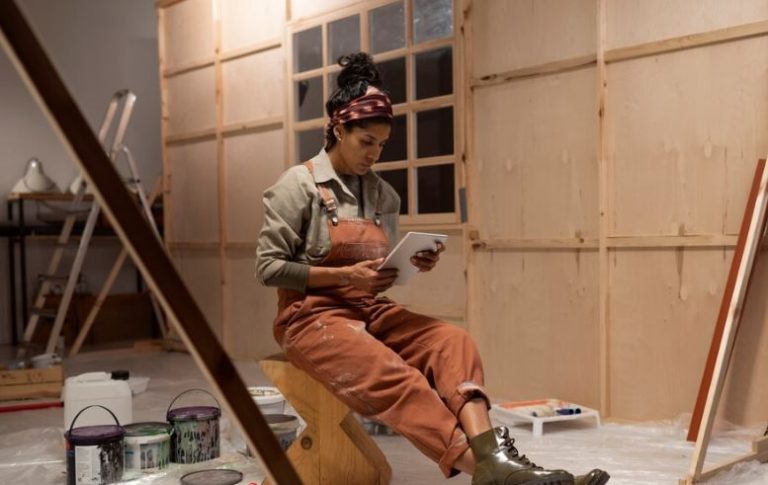It’s like tuning an old piano when you renovate a house from the 1930s. Even though it has some wear from years of use and a few misplaced keys, its beauty can be clearly restored with the right care. Plaster ceilings, coal sheds, fireplaces designed for a different era—these houses present remarkably similar challenges, but they also present especially endearing opportunities.
How a Couple Created Their Dream Home Out of a 1930s Semi
First-time UK renovators Fifi and Neil McGee faced a significant obstacle when they entered the real estate market: finding a home in a competitive market on a tight budget. Their remedy? They meticulously renovated an unaltered semi-detached house from the 1930s, one dusty room at a time. Starting in 2016, their project developed into an online journal of insights, failures, victories, and, in the end, a tale of personal growth.
Key Project Information Table
Below is a quick reference for inserting into WordPress:
| Project Detail | Information |
|---|---|
| Property Type | 1930s Semi-Detached |
| Renovation Start Date | 2016 |
| Location | Brighton, United Kingdom |
| Duration | 18 months |
| Total Budget | £80,000 (approx.) |
| Notable Challenges | Asbestos removal, no central heating, outdated insulation |
| Major Updates | New kitchen-diner, driveway, home office, central heating, loft remodeling |
| Professional Involvement | Architect initially, later direct builder engagement |
| Renovation Philosophy | “Cosy, functional, and timeless” |
Remodeling as Therapy: The Surprising Pleasures of Creating a Life Together
They desired a space that would change with their lives, not just a space with lots of square footage. They created a house where every corner has a story by removing old wallpaper, redesigning floor plans, and repurposing old rooms. It was a particularly taxing but incredibly rewarding process.
With tears in her eyes, Fifi remembers sanding walls: “It felt like reclaiming something—it didn’t feel like work.” Many first-time homeowners who are faced with a similar task and must redefine what a home really means will find resonance in her candor.
Interior Designers Discuss What They Learned from Remodeling in the 1930s
Nottingham-based interior designer Meera started her own remodeling project in the 1930s. Her family converted a 1980s-era home that was mostly beige into a large, light-filled haven. Notably, she worked on everything from custom library spaces to underfloor heating. Due to scope expansion, contractor delays, and budgetary restrictions, the renovation took nine months instead of the originally projected four.
The family did, however, find a rhythm in spite of the slow progress. During construction, they temporarily relocated, came back stronger, and put the finishing touches on their own, including painting, installing handles, and making sure all the switches lined up precisely. For those working on related projects, her blog provides especially creative insights.
Creating an Intentional Budget: What the Data Don’t Show
The renovation of the McGees required incredibly precise budgetary planning. They made a live spreadsheet and entered estimates and actual prices into it. Everything had a line item, from £2,000 kitchen installations to £5 electrical switches. Their approach was very effective, especially when unforeseen expenses surfaced, like the need for 14 skips rather than the builder’s estimated three.
Fifi gives advice to anyone thinking about doing a similar renovation: “Don’t start with an architect.” Have a vision first. You create stories; architects create structures.
Renovating with Soul: Discovering Purpose in Drafts and Dust
These families benefited from more than just larger bathrooms and insulated walls. They experienced the delight of waking up in an area completely created by them. Every radiator, every repointed brick, and every skirting board installed became a tangible representation of perseverance and hope.
Once chilly, rickety, and stuck in the past, their refurbished homes now reflect contemporary goals without erasing the past. To preserve the integrity of the period, they used natural, breathable materials, restored original fireplaces, and preserved cornices. Renovation becomes incredibly effective at that point because it embraces the present while paying tribute to the past.
Surprising Findings Below the Surface
Under layers of shaggy old carpet, Fifi and Neil found original herringbone parquet, which was a particularly charming twist. Neil jokingly remarked, “It was like opening a forgotten birthday present.” Renovations in the 1930s are emotionally satisfying because of these unintentional finds. Sturdy materials and classic details are frequently hiding beneath the worn-out finishes, just waiting to be revealed.
Regaining More Than Just Physical Property
The goal of renovating a 1930s home is to make it uniquely yours, not just to make it appear brand new. It’s about rebuilding not just a property but also your self-assurance in producing something worthwhile. With their quiet stoicism and rounded corners, these houses preserve history with understated dignity.
Owners become more than just renovators when they take charge, managing trades, choosing where to save and where to spend, and designing the layout. They take on the roles of guardians of cultural heritage, storytellers of space, and active producers of their own surroundings.
What Ordinary Homeowners Can Learn From Celebrity Restorations
Celebrity-driven renovations, such as those spearheaded by Hollywood designers or Instagram influencers, are shedding light on the timeless appeal of historic homes throughout the design and entertainment sectors. They emphasize emotional impact in addition to aesthetic improvements. This explains why programs like “Dream Home Makeover” continue to be popular year after year. They affirm that remodeling a house is more than just building; it’s a narrative.
Just as compelling are the tales of regular homeowners like Meera or Fifi. They teach that the process of reshaping something that was on the verge of being lost is what defines beauty rather than perfection.
FAQs
What are common challenges when renovating a 1930s house?
Many 1930s homes contain asbestos, outdated wiring, and lack modern insulation.
How much should I budget for a full renovation of a 1930s house?
Depending on scope and location, costs can range from £70,000 to £150,000 or more.
Is it possible to live in the house during renovation?
It’s possible, but not recommended during major structural or utility work.
Are 1930s houses good for modern open-plan living?
Yes, but may require removing load-bearing walls and installing steel support.
What should be prioritized during early renovation planning?
Electricals, plumbing, insulation, and structural integrity should come first.


